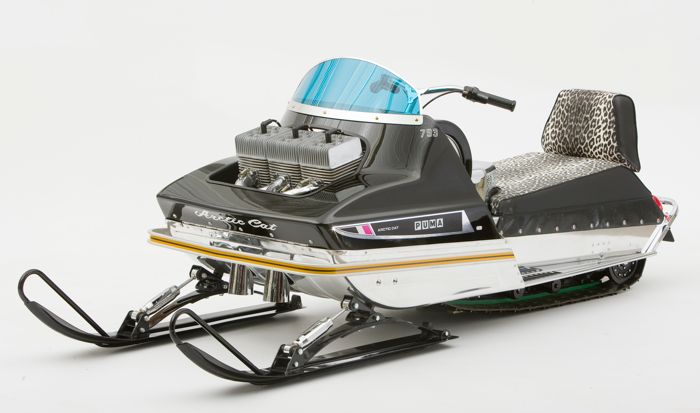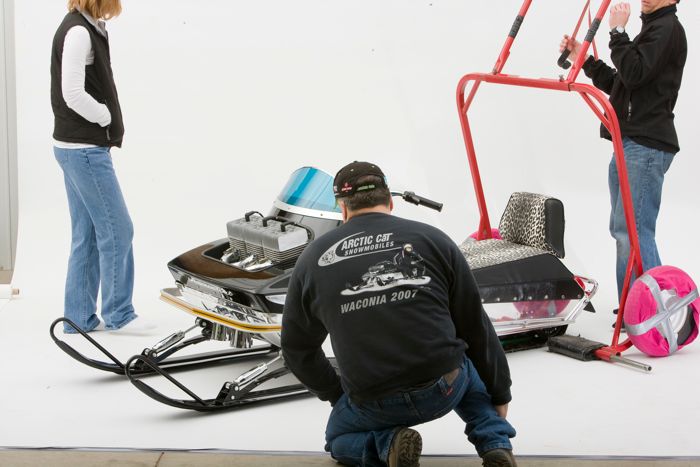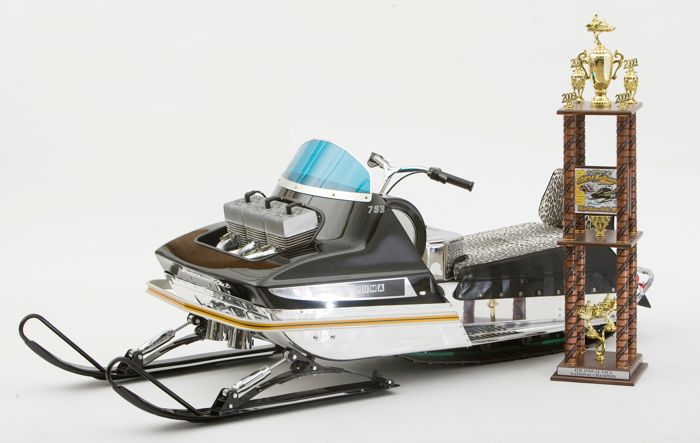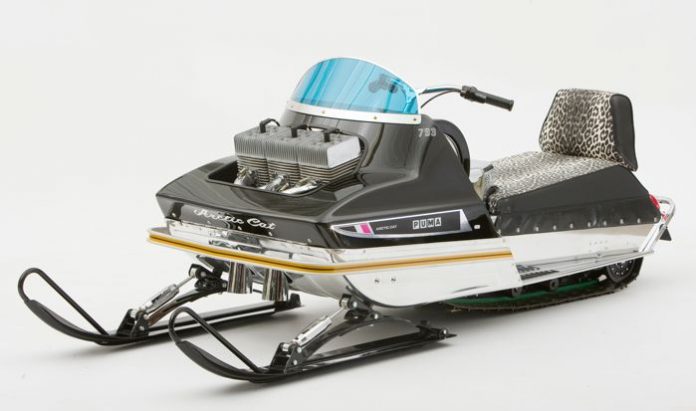
This stunning, restored 1970 Arctic Cat 793 Puma is collector Nancy Ische’s pride and joy. And for good reason.
The 1970 Puma models introduced the first “short” chassis Arctic Cat models of the period, featuring a 17 x 103.5-in. track instead of the 17 x 126.5-in. track (and longer tunnel) on the Panther models. The goal of the shorter track/chassis was to make a quicker turning/handling sled than the Panther.
It was powered by the monster 793cc Hirth triple, with a 3-into-2 megaphone exhaust that dumps through the bellypan. Arctic Cat first used the Hirth triple the prior year on a handful of Panther mod sleds. It was one of a handful of big, powerful engines built for the fledgling snowmobile industry during the onset of the first musclesled era.
Nancy Ische and her husband Tom bought this sled from a seller located north of Warren, Minn., about a decade ago. It was mostly complete, including the serial # production tag, but missing the motor.
“The chassis was straight,” says Tom. “I put a new bellypan on it, but everything else was in good shape. It has a different hood on it, but I still have the original.”
Ische bought the NOS engine from a dealer who had it sitting on a shelf. He added to the machine an NOS seat, backrest and track, then completed the restoration in the 2005-2006 timeframe.
So stunning and impeccable in its quality, the sled won the 2009 Vintage Snowmobile Club of American Nationals in 2009 for Nancy.
For Nancy???
“In our household, this sled is Nancy’s,” says Tom with a chuckle. “It’s her baby.”
According to semi-official sources, there were only three production 1970 Puma 793, but Tom questions the accuracy of that claim.
“Three is the number that people say, but it seems like they would have made more than that. We don’t know for sure.
“We know that back in the day there were people who were converting 793 Panthers into Pumas by swapping the tunnel and track. Arctic Cat made approximately 94 of the Panthers.”
You could say that the 1970 763 Puma set the stage for the three 1971 King Kat models, which also featured a short chassis (although longer than the Puma’s). The three King Kat models included a 793cc Hirth powered version (with tuned pipes) that slotted in-between the 650 JLO triple and 800 four-banger Kawasaki.
History would prove that the Puma chassis was too short for adequate traction, but the idea of a big engine (standing tall and outside of the hood) would define Arctic Cat race and musclesleds for years to come.
Even today, the powerful beauty of such sleds stops people in their tracks.
Nancy continues to show her ’70 Puma at various events. If you’re lucky enough to see it in person, you’ll know why it’s her favorite.
Thanks for reading.

Setting up the “studio” shot of Nancy Ische’s 1970 Arctic Cat 793 Puma. Tom Ische in the foreground.

Winner of the 2009 VSCA Nationals.

Nancy and her baby.




Sweet.
That is really flippin cool!
Very nice and classy!!!!!!
What I’ve dug up on these over the years is that the factory Cat race team found that when the power came on in the corner exit the 793 Puma wanted to swap ends. Early stud tech was only of minimal help. They immediately started development on the mid sized King Kat chassis, which has a track that slots between the Puma and the Panther, but a wider front end for more stability. By about late January of the 1970 race season Team Arctic was already racing KK proto test mules in the 800 Mod class. Any modified/converted 793 Puma fame based machines wound up in the distributor pipeline to be sold to independants. I’ve heard the 3 production number too, but I also think several were built/converted from scratch as the Honker was the dominant selling 800 class motor back then. The early 793 Puma’s have three straight megs. They quickly found out that the three into two header gave more power. All part of the learning ladder to the development of tuned exhaust, which was better than open megs.
Cool article. When we first bought our cabin, our full time residence now, there was a 793 sitting back in the woods. I never looked at it close enough to see if it was a Puma chassis. It was hauled off somewhere by the neighbor who has since passed away. Treasure lost !?
where would a guy like me find a three into 2 header pipe.
she’s beauty
Our family had an arctic dealership back in 1971 also a race team we got a 793 puma from the factory that they raced in Lake Tahoe the year before it had an alcohol motor it was a handful wrecked as much as it raced
Jerry kienbaum from Spokane found it and brought it by a few years ago
He claimed it was one of 3 and the only 1 that was a snopro
Jerry will be missed he was a wealth of knowledge
what a great article,what a great sled,i have a puma 793 1970 in my collection,my nexr dream is a kk800″ ,may be one day,for now,i lift you my hat to taking the time and and the money to making a beautiful project like this,beautiful cat like this is a kinda rare here up north in quebec in canada,hope to shake your hand one day,best regards martin
hi,
i have a moto-ski bullet 793 hirth. having a hard time making it run and sound good when i hit the throttle. idle run smooth and dry sound at exhaust but at full throttle, sounds like missing fire on one or i don’t know.
canyou help me?
thanks
Claudel